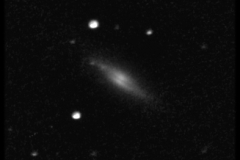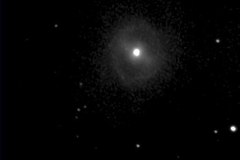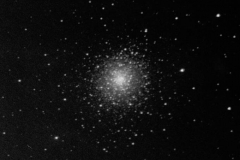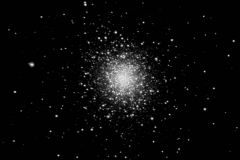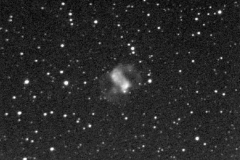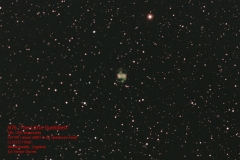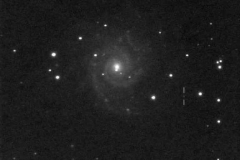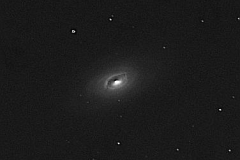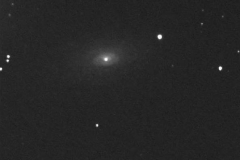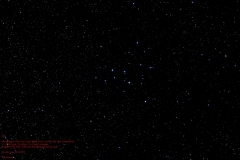[et_pb_section fb_built="1" _builder_version="3.22"][et_pb_row _builder_version="3.25" background_size="initial" background_position="top_left" background_repeat="repeat"][et_pb_column type="4_4" _builder_version="3.25" custom_padding="|||" custom_padding__hover="|||"][et_pb_text _builder_version="3.27.4"]
The Pinwheel Galaxy (also known as Messier 101, M101 or NGC 5457) is a face-on spiral galaxy distanced 21 million light-years (six megaparsecs) away from Earth in the constellation Ursa Major. First discovered by Pierre Méchain on March 27, 1781, it was communicated to Charles Messier who verified its position for inclusion in the Messier Catalogue as one of its final entries.
[/et_pb_text][/et_pb_column][/et_pb_row][et_pb_row _builder_version="3.25" background_size="initial" background_position="top_left" background_repeat="repeat"][et_pb_column type="4_4" _builder_version="3.25" custom_padding="|||" custom_padding__hover="|||"][et_pb_text admin_label="Images by Kevin Langford" _builder_version="3.18.7" global_module="3167" saved_tabs="all"]
Images by Kevin Langford
[/et_pb_text][/et_pb_column][/et_pb_row][et_pb_row _builder_version="3.25" background_size="initial" background_position="top_left" background_repeat="repeat" column_structure="1_4,1_4,1_4,1_4"][et_pb_column type="1_4" _builder_version="3.25" custom_padding="|||" custom_padding__hover="|||"][et_pb_text admin_label="KL Image" _builder_version="3.27.4" z_index_tablet="500"]

[/et_pb_text][/et_pb_column][et_pb_column type="1_4" _builder_version="3.25" custom_padding="|||" custom_padding__hover="|||"][/et_pb_column][et_pb_column type="1_4" _builder_version="3.25" custom_padding="|||" custom_padding__hover="|||"][/et_pb_column][et_pb_column type="1_4" _builder_version="3.25" custom_padding="|||" custom_padding__hover="|||"][/et_pb_column][/et_pb_row][et_pb_row _builder_version="3.25" background_size="initial" background_position="top_left" background_repeat="repeat"][et_pb_column type="4_4" _builder_version="3.25" custom_padding="|||" custom_padding__hover="|||"][et_pb_text admin_label="Images by Julian Tworek" _builder_version="3.16" global_module="2598" saved_tabs="all"]
Images By Julian Tworek
[/et_pb_text][/et_pb_column][/et_pb_row][et_pb_row _builder_version="3.25" background_size="initial" background_position="top_left" background_repeat="repeat" column_structure="1_4,1_4,1_4,1_4"][et_pb_column type="1_4" _builder_version="3.25" custom_padding="|||" custom_padding__hover="|||"][et_pb_text admin_label="JT Image" _builder_version="3.27.4"]
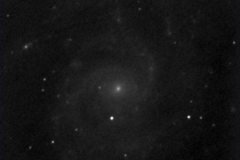
[/et_pb_text][/et_pb_column][et_pb_column type="1_4" _builder_version="3.25" custom_padding="|||" custom_padding__hover="|||"][/et_pb_column][et_pb_column type="1_4" _builder_version="3.25" custom_padding="|||" custom_padding__hover="|||"][/et_pb_column][et_pb_column type="1_4" _builder_version="3.25" custom_padding="|||" custom_padding__hover="|||"][/et_pb_column][/et_pb_row][et_pb_row _builder_version="4.4.2"][et_pb_column _builder_version="4.4.2" type="4_4"][et_pb_text admin_label="Images by Neil Webster" _builder_version="3.27.4" saved_tabs="all" global_module="3174"]
Images by Neil Webster
[/et_pb_text][/et_pb_column][/et_pb_row][et_pb_row _builder_version="4.4.2" column_structure="1_4,1_4,1_4,1_4"][et_pb_column _builder_version="4.4.2" type="1_4"][et_pb_text _builder_version="4.4.2" hover_enabled="0"]
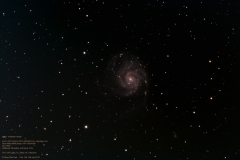
[/et_pb_text][/et_pb_column][et_pb_column _builder_version="4.4.2" type="1_4"][/et_pb_column][et_pb_column _builder_version="4.4.2" type="1_4"][/et_pb_column][et_pb_column _builder_version="4.4.2" type="1_4"][/et_pb_column][/et_pb_row][et_pb_row _builder_version="4.4.2"][et_pb_column _builder_version="4.4.2" type="4_4"][et_pb_text admin_label="Images by Simon Dawes" _builder_version="3.27.4" saved_tabs="all" global_module="2572"]
Images by Simon Dawes
[/et_pb_text][/et_pb_column][/et_pb_row][et_pb_row _builder_version="4.4.2" column_structure="1_4,1_4,1_4,1_4"][et_pb_column _builder_version="4.4.2" type="1_4"][et_pb_text _builder_version="4.4.2" hover_enabled="0"]
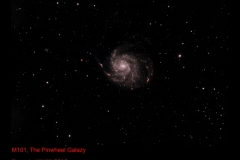
[/et_pb_text][/et_pb_column][et_pb_column _builder_version="4.4.2" type="1_4"][/et_pb_column][et_pb_column _builder_version="4.4.2" type="1_4"][/et_pb_column][et_pb_column _builder_version="4.4.2" type="1_4"][/et_pb_column][/et_pb_row][et_pb_row _builder_version="3.25" background_size="initial" background_position="top_left" background_repeat="repeat"][et_pb_column type="4_4" _builder_version="3.25" custom_padding="|||" custom_padding__hover="|||"][et_pb_text admin_label="Messier Links" _builder_version="4.3.2" z_index_tablet="500" global_module="2601" saved_tabs="all"]
| M1 | M2 | M3 | M4 | M5 | M6 | M7 | M8| M9 | M10 | M11 | M12 | M13 | M14 | M15 | M16 | M17 | M18 | M19 | M20 | M21 | M22 | M23 | M24 | M25 | M26 | M27 | M28 | M29 | M30 | M31 | M32 | M33 | M34 | M35 | M36 | M37 | M38 | M39 | M40 | M41 | M42 | M43 | M44 | M45 | M46 | M47 | M48 | M49 | M50 | M51 | M52 | M53 | M54 | M55 | M56 | M57 | M58 | M59 | M60 | M61 | M62 | M63 | M64 | M65| M66 | M67 | M68 | M69 | M70 | M71 | M72 | M73 | M74 | M75 | M76 | M77 | M78 | M79 | M80 | M81 | M82 | M83 | M84 | M85 | M86 | M87 | M88 | M89 | M90 | M91 | M92 | M93 | M94 | M95 | M96 | M97 | M98 | M99 | M100 | M101 | M102 | M103 | M104 | M105 | M106 | M107 | M108 | M109 | M110 |
[/et_pb_text][et_pb_text admin_label="Copyright Notice" _builder_version="3.9" global_module="638" saved_tabs="all"]
All images are copyright. Permission must be sought to from the image owner to the use of any of these images.
[/et_pb_text][/et_pb_column][/et_pb_row][/et_pb_section]
 We hosted The 2018 British Astronomical Association Back to Basics workshop on 6th October.
We hosted The 2018 British Astronomical Association Back to Basics workshop on 6th October. 
